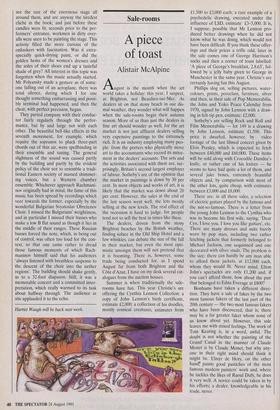Sale-rooms
A piece of toast
Alistair McAlpine
August is the month when the art world takes a holiday: this year, I suspect, at Brighton, not Beaulieu-sur-Mer. As dealers sit on that stony beach in our dis- mal weather, they wonder what will happen when the sale-rooms begin their autumn season. More of us than just the dealers in fine art should wonder as well, for the art market is not just affluent dealers selling very expensive paintings to the extremely rich. It is an industry employing many peo- ple: from the porters who physically move art to the accountants who record its Wive- ment in the dealers' accounts. The arts and the activities associated with them are, sur- prisingly, Britain's second largest employer of labour. Sotheby's are of the opinion that the market in paintings is down by 30 per cent. In most objects and works of art, it is likely that the market was down about 20 per cent. However, the sales at the end of the last season went well, the lots mostly selling at the new levels. The real effect of the recession is hard to judge, for people tend not to sell the best in times like these.
The dealers, driven from the stony Brighton beaches by the British weather, finding solace in the Old Ship Hotel and a few whiskies, can debate the size of the fall in their market, but even the most opti- mistic amongst them will not pretend that it is booming. There is, however, some trade being conducted for, as I spend August far from both Brighton and the Cote d'Azur, I have on my desk several cat- alogues from the auction houses.
Summer is when traditionally the sale- rooms have fun. This year Christie's are offering the Cynthia Lennon Collection: a copy of John Lennon's birth certificate, estimate £2,000; a collection of his doodles, mostly comical creatures, estimates from £1,500 to £3,000 each; a rare example of a psychedelic drawing, executed under the influence of LSD, estimate £3-5,000. It is, I suppose, possible that Mr Lennon pro- duced better drawings when he did not know what he was doing, which would not have been difficult. If you think these offer- ings and their prices a trifle odd, later in the sale comes one of George Harrison's socks and then a corner of toast labelled: `A piece of George's breakfast, 2.8.63', fol- lowed by a jelly baby given to George in Manchester in the same year. Christie's are certainly having fun this August.
Phillips slog on, selling pictures, water- colours, prints, porcelain, furniture, silver and then, in their sale of Pop Memorabilia, the John and Yoko Peace Calendar from 1970, signed by John Lennon with a draw- ing in felt-tip pen, estimate: £2,000.
Sotheby's are selling Rock and Roll and Film Memorabilia — lot 149 is a drawing by John Lennon, estimate £1,500. This price is dwarfed, however, by video footage of the last filmed concert given by Elvis Presley, which is expected to fetch between £40,000 and £60,000. These items will be sold along with Crocodile Dundee's knife, or rather one of his knives — he seems to have had quite a lot of them, and several juke boxes, extremely beautiful objects and, by comparison with most of the other lots, quite cheap, with estimates between £3,000 and £8,000.
There are, in all these sales, a selection of electric guitars played by the famous and the not-so-famous. There is a letter from the young John Lennon to the Cynthia who was to become his first wife, saying, 'Dear Cyn, I love you. I love you like guitars', etc. There are many dresses and suits barely worn by pop stars, including two rather fetching jackets that formerly belonged to Michael Jackson, one sequinned and one decorated with silver studs. The problem is the size: there can hardly be any man able to afford these jackets, at £12,000 each, whom they would fit. Never mind, Elton John's spectacles are only £1,200 and, if you can't afford those, how about the pair that belonged to Edna Everage at £800?
Bonhams have taken a different direc- tion. They have a sale of fakes by the two most famous fakers of the last part of the 20th century — the two most famous fakers who have been discovered, that is; there may be a far greater faker whom none of us know about yet. However, this sale leaves me with mixed feelings. The work of Tom Keating is, in a word, awful. The doubt is not whether the painting of the Grand° Canal in the manner of Claude Monet is by Claude Monet, but why any- one in their right mind should think it might be. Elmyr de Hory, on the other hands, paints good pastiches of the most famous modern painters' work and, where he tackles the likes of Raoul Duly, he does it very well. A novice could be taken in by his efforts; a dealer, knowledgeable in his trade, never.


















































 Previous page
Previous page